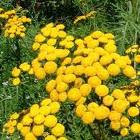This stinking hellebore is a native of the British Isles and western and Central Europe and is so named because of the unpleasant odour it emits from its leaves if they are bruised. It is semi-evergreen and flowers in winter from December through to April and is distinctive in woodland with its erect stem which can grow to around 60 centimetres and even a metre after a few years, and its bell-shaped green flowers with their purple-tinged petals. Its other names are Ox heel and Stinkwort. One plant will have perhaps hundreds of single flowers during its blooming period, so it is well-liked by gardeners because it gives colour to a garden in winter.
Like its relative the Christmas or Lenten rose (Helleborus niger
It is a member of the Ranunculaceae family so is related to buttercups, marsh marigolds, black cohosh, goldenseal and the Lesser Celandine.
It has been used traditionally to lower high blood pressure, as it contains the alkaloids, nervine, pseudo-nervine and veritridine, which are found in the root, harvested in the autumn and dried for later use. It has similar properties to the Christmas rose. Dioscorides used Hellebore for skin problems and the juice was suggested as being a cure for deafness if dropped into the ears, although it would be very unwise to try this.
It should be remembered that the old apothecaries knew what dosages were safe, while we as laypersons don’t, and they probably knew through trial and error which meant some fatalities.
“A day or two ye shul have digestyves
Of wormes, er ye take youre laxatyves
Of lawriol, centaure, and fumetere,
Or elles of ellebor, that groweth there,”
Of wormes, er ye take youre laxatyves
Of lawriol, centaure, and fumetere,
Or elles of ellebor, that groweth there,”
Hellebore was used as a laxative and to get rid of intestinal worms in the Middle Ages, but it is a drastic purgative (even more so than jamalgota) and not to be tried. In this quotation Chaucer refers to the herbs that were used in his time (14th century) for these properties, namely:-laurel (the bay leaf tree), centaury, fumitory and this hellebore (ellebor).
 The root is violently narcotic and despite this was used to regulate a woman’s periods, as a purgative, diuretic, for nervous problems and hysteria and a local irritant – which means that people used it as the Roman soldiers in Britain reportedly used nettles, to escape from one pain to another.
The root is violently narcotic and despite this was used to regulate a woman’s periods, as a purgative, diuretic, for nervous problems and hysteria and a local irritant – which means that people used it as the Roman soldiers in Britain reportedly used nettles, to escape from one pain to another. It is becoming rare in Britain























